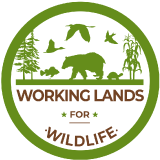-
Coastal Resilience Maine
-
by
Tab Manager
—
published
Apr 10, 2024
—
last modified
Apr 21, 2025 06:27 PM
—
filed under:
Maps,
Maps and Data,
WLFW,
Coastal Resiliency
Allows users to explore barriers to aquatic connectivity — dams and road-stream crossings– and identify likely high priorities for removal or improved fish passage for different objectives as well as to run custom analyses.
Located in
Learning & Tech Transfer
/
Apps, Maps, & Data
-
National Aquatic Barrier Inventory & Prioritization Tool
-
by
Tab Manager
—
published
Apr 10, 2024
—
last modified
Apr 21, 2025 06:26 PM
—
filed under:
Maps,
Maps and Data,
WLFW
Improve aquatic connectivity by prioritizing aquatic barriers for removal using the best available data.
Located in
Learning & Tech Transfer
/
Apps, Maps, & Data
-
Trout Unlimited Brook Trout Atlas
-
by
Tab Manager
—
published
Apr 10, 2024
—
last modified
Apr 21, 2025 06:26 PM
—
filed under:
Brook Trout,
Trout Unlimited,
Maps and Data,
WLFW
The following interactive atlases provide a means to explore mapped data related to brook trout populations, habitats, and threats in local watersheds and across their eastern range.
Located in
Learning & Tech Transfer
/
Apps, Maps, & Data
-
Brook Trout Conservation Portfolio and Range-wide Assessment
-
by
Tab Manager
—
published
Apr 10, 2024
—
last modified
Apr 21, 2025 06:26 PM
—
filed under:
Brook Trout,
Maps and Data,
WLFW
Interactive webmap and visualization tools.
Located in
Learning & Tech Transfer
/
Apps, Maps, & Data
-
Fish Habitat Decision Support Tool
-
by
Tab Manager
—
published
Apr 11, 2024
—
last modified
Apr 21, 2025 06:26 PM
—
filed under:
2013 Accomplishment Report,
Maps and Data,
WLFW
This tool was created to provide resource managers and the general public with access to the extensive spatial data and results produced from multiple fish habitat assessments. Three main analytical tools (visualization, ranking, and futuring) are combined with intuitive base-maps and mapping features to allow users to explore the details of the assessments and perform subsequent analyses.
Located in
Learning & Tech Transfer
/
Apps, Maps, & Data
-
Riparian Restoration Decision Support Tool
-
by
Tab Manager
—
published
Apr 11, 2024
—
last modified
Apr 21, 2025 06:26 PM
—
filed under:
Maps and Data,
WLFW
An innovative riparian planting and restoration decision support tool, this user-friendly tool allows managers and decision-makers to rapidly identify and prioritize areas along the banks of rivers, streams, and lakes for restoration, making these ecosystems more resilient to disturbance and future changes in climate.
Located in
Learning & Tech Transfer
/
Apps, Maps, & Data
-
Brook Trout Thermal Habitat Forecasts Catoctin Mountain Park, Maryland & Shenandoah Valley, Virginia
-
by
Tab Manager
—
published
Apr 11, 2024
—
last modified
Apr 21, 2025 06:26 PM
—
filed under:
Brook Trout,
Maps and Data,
WLFW
Users can zoom-in to an area of interest and then compare current conditions against various future scenarios (3 levels of air temperature change x 3 levels of GW sensitivity to air temperature change). The interpretation is simple: red sites are too warm (MWAT > 23 C) and blue sites have suitable temperatures.
Located in
Learning & Tech Transfer
/
Apps, Maps, & Data
-
North Atlantic Aquatic Connectivity Collaborative
-
by
Tab Manager
—
published
Apr 11, 2024
—
last modified
Apr 21, 2025 06:26 PM
—
filed under:
Maps and Data,
WLFW
The North Atlantic Aquatic Connectivity Collaborative (NAACC) is a network of individuals from universities, conservation organizations, and state and federal natural resource and transportation departments focused on improving aquatic connectivity across a thirteen- state region, from Maine to West Virginia.
Located in
Learning & Tech Transfer
/
Apps, Maps, & Data
-
SE FireMap
-
by
Tab Manager
—
published
Apr 21, 2025
—
filed under:
Apps, Maps, & Data,
WLFW
The SE FireMap project aims to develop an improved fire mapping system in the Southeastern United States. This cohesive system will track both prescribed fire and wildfire activity on public and private lands and serve as a critical decision support tool to maximize the effectiveness of fire management practices.
Located in
Learning & Tech Transfer
/
Apps, Maps, & Data
-
The Literature Gateway
-
by
Tab Manager
—
published
Apr 21, 2025
—
last modified
Apr 21, 2025 06:36 PM
—
filed under:
Apps, Maps, & Data,
WLFW
Forest managers, wildlife conservation groups, policy makers, and other stakeholders often need to review literature on forest bird-vegetation relationships to inform decisions on natural resource management or ecosystem restoration. The literature gateway facilitates the exploration of this literature, helping users find references on a diverse range of management-relevant topics that have been compiled by subject experts based on searches of >60 different sources spanning the past 50+ years.
Located in
Learning & Tech Transfer
/
Apps, Maps, & Data


